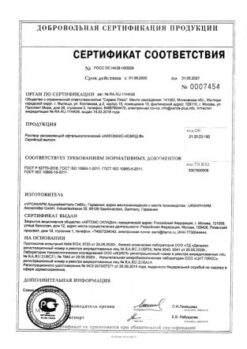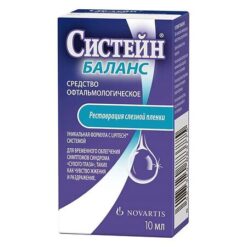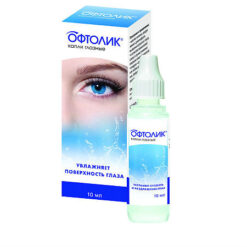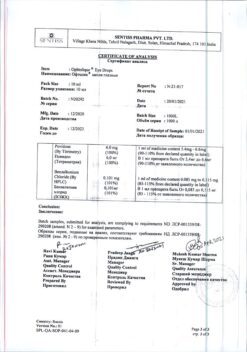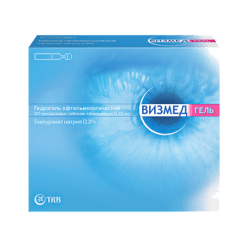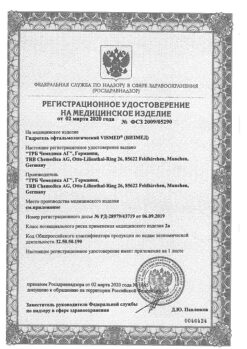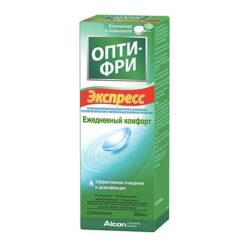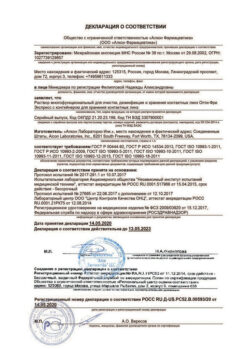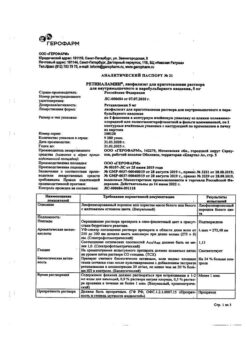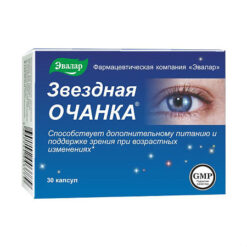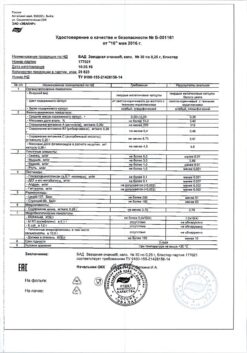No products in the cart.
Irifrin BK, eye drops 2.5% 0.4 ml 15 pcs
€20.65 €17.21
Description
Irifrin BC has alpha-adrenomimetic action.
Pharmacodynamics
Phenylephrine is an adrenomimetic. It has pronounced alpha-adrenergic activity and has no significant stimulating effect on the CNS when used in normal doses.
When used topically in ophthalmology, it causes dilation of the pupil, improves the outflow of intraocular fluid and narrows the conjunctival vessels.
Phenylephrine has a strong stimulatory effect on the postsynaptic alpha-adrenoreceptors, it has very little effect on the beta-adrenoreceptors of the heart, it has almost no positive chronotropic and inotropic effect on the heart. The drug has a vasoconstrictor effect similar to that of norepinephrine (noradrenaline). The vasopressor effect of phenylephrine is weaker than that of norepinephrine, but it is more durable. It causes vasoconstriction 30-90 s after instillation, the duration is 2-6 h.
Phenylephrine contracts the dilator of the pupil after instillation, thereby causing dilation of the pupil and smooth muscles of the conjunctival arterioles. Midriasis occurs within 10-60 min after a single injection; it lasts for 2 h after 2.5% solution; 3-6 h after 10% solution. Midriasis caused by phenylephrine is not accompanied by cycloplegia.
Pharmacokinetics
Phenylephrine easily penetrates into the eye tissues, Cmax in plasma occurs 10-20 min after local administration. Prior instillation of local anesthetics may increase systemic absorption and prolong mydriasis. Phenylephrine is excreted unchanged in the urine.
Indications
Indications
iridocyclitis (to prevent the occurrence of posterior synechiae and reduce exudation in the iris);
pupil dilation during ophthalmoscopy and other diagnostic procedures necessary to monitor the condition of the posterior segment of the eye;
conducting a provocative test in patients with a narrow anterior chamber angle profile and suspected angle-closure glaucoma;
differential diagnosis of superficial and deep injection of the eyeball;
in ophthalmic surgery during preoperative preparation for pupil dilation (10% solution);
performing laser interventions on the fundus and in vitreoretinal surgery;
treatment of glaucomocyclic crises;
red eye syndrome treatment
Pharmacological effect
Pharmacological effect
Irifrin BC has an alpha-adrenomimetic effect.
Pharmacodynamics
Phenylephrine is an adrenergic agonist. It has pronounced alpha-adrenergic activity and, when used in normal doses, does not have a significant stimulating effect on the central nervous system.
When applied topically in ophthalmology, it causes dilation of the pupil, improves the outflow of intraocular fluid and constricts the vessels of the conjunctiva.
Phenylephrine has a pronounced stimulating effect on postsynaptic alpha-adrenergic receptors, has a very weak effect on beta-adrenergic receptors of the heart, and has virtually no positive chronotropic and inotropic effects on the heart. The drug has a vasoconstrictor effect similar to that of norepinephrine (norepinephrine). The vasopressor effect of phenylephrine is weaker than that of norepinephrine, but is longer lasting. Causes vasoconstriction 30-90 s after instillation, duration – 2-6 hours.
After instillation, phenylephrine contracts the pupillary dilator, thereby causing pupillary dilation and conjunctival arteriole smooth muscle. Mydriasis occurs within 10–60 minutes after a single instillation; continues after instillation of a 2.5% solution for 2 hours; 10% solution – 3-6 hours. Mydriasis caused by phenylephrine is not accompanied by cycloplegia.
Pharmacokinetics
Phenylephrine easily penetrates into the eye tissue, Cmax in plasma occurs 10–20 minutes after topical application. Pre-instillation of local anesthetics may increase systemic absorption and prolong mydriasis. Phenylephrine is excreted unchanged in the urine (
Active ingredient
Active ingredient
Phenylephrine
Composition
Composition
Active ingredient:
phenylephrine hydrochloride 25 mg;
Excipients:
disodium edetate 1.0 mg,
sodium metabisulfite 2.0 mg,
citric acid 1.16 mg,
sodium citrate dihydrate.e.,
hyprmellose 3.0 mg,
water for injection q.s.
Pregnancy
Pregnancy
Pregnancy
In animals in late pregnancy, phenylephrine caused fetal growth retardation and stimulated early onset of labor.
The effect of Irifrin BC in pregnant women has not been sufficiently studied, therefore the drug should be used in this category of patients only if the expected benefit to the mother outweighs the risk of possible side effects to the fetus.
Lactation
If the drug is prescribed during lactation, breastfeeding should be stopped.
Contraindications
Contraindications
hypersensitivity to the drug;
narrow-angle or closed-angle glaucoma;
old age with serious disorders of the cardiovascular or cerebrovascular system;
additional dilation of the pupil during surgical operations in patients with a violation of the integrity of the eyeball, as well as in cases of impaired tear production;
hyperthyroidism;
hepatic porphyria;
congenital deficiency of glucose-6-phosphate dehydrogenase;
children under 12 years of age and patients with arterial aneurysm (10% solution);
premature babies (2.5% solution).
With caution: patients with type 2 diabetes mellitus (increased risk of increased blood pressure associated with impaired autonomic regulation); elderly patients (increased risk of reactive miosis); simultaneous use with MAO inhibitors and for 21 days after stopping their use; due to the fact that it causes hypoxia of the conjunctiva: patients with sickle cell anemia, wearing contact lenses, after surgery (decreased healing).
Side Effects
Side Effects
Local
Conjunctivitis, periorbital edema. In some cases, patients note a burning sensation (at the beginning of use), blurred vision, irritation, discomfort, lacrimation, and increased intraocular pressure.
Phenylephrine may cause reactive miosis the day after use; at this time, repeated instillations of drugs may produce less pronounced mydriasis than the day before; the effect is more common in older patients.
Due to the significant contraction of the pupil dilator under the influence of phenylephrine, 30–45 minutes after instillation, pigment particles from the pigment layer of the iris may be detected in the aqueous humor of the anterior chamber of the eye. Suspension in the chamber fluid must be differentiated from manifestations of anterior uveitis or the ingress of blood cells into the fluid of the anterior chamber.
Systemic: contact dermatitis.
From the cardiovascular system: rapid heartbeat, tachycardia, cardiac arrhythmia, increased blood pressure, ventricular arrhythmia, reflex bradycardia, coronary artery occlusion, pulmonary embolism.
In rare cases, after topical use of a 10% phenylephrine solution, myocardial infarction, vascular collapse and intracranial hemorrhage may develop.
Interaction
Interaction
The mydriatic effect of phenylephrine is enhanced when used in combination with topical atropine. Due to increased vasopressor action, tachycardia may develop.
The use of Irifrin BC within 21 days after the patient has stopped taking monoamine oxidase inhibitors and tricyclic antidepressants should be done with caution, since in this case there is the possibility of an uncontrolled rise in blood pressure.
The vasopressor effect of adrenergic agents may also be potentiated when used in combination with tricyclic antidepressants, beta-blockers, reserpine, guanethidine, methyldopa and m-anticholinergics.
Irifrin BC may potentiate the inhibition of cardiovascular activity during inhalation anesthesia as a result of increased myocardial sensitivity to sympathomimetics and the occurrence of ventricular fibrillation.
Use together with other sympathomimetics may increase the cardiovascular effects of phenylephrine.
The use of phenylephrine may weaken concomitant antihypertensive therapy and lead to an increase in blood pressure and tachycardia.
Pre-instillation of local anesthetics may increase systemic absorption and prolong mydriasis.
Overdose
Overdose
Symptoms: overdose are restlessness, nervousness, dizziness, sweating, vomiting, rapid heartbeat, weak or shallow breathing.
Treatment: if systemic effects of phenylephrine occur, side effects can be stopped by using alpha-adrenergic blocking agents, for example, 5 to 10 mg of phentolamine intravenously.
If necessary, the injection can be repeated.
Storage conditions
Storage conditions
In a place protected from light, at a temperature not exceeding 25 °C. Do not freeze.
Shelf life
Shelf life
2 years
Manufacturer
Manufacturer
Sentiss Pharma Pvt.Ltd, India
Additional information
| Shelf life | 2 years |
|---|---|
| Conditions of storage | In a light-protected place at a temperature not exceeding 25 °C. Do not freeze. |
| Manufacturer | Sentiss Pharma Pvt.Ltd, India |
| Medication form | eye drops |
| Brand | Sentiss Pharma Pvt.Ltd |
Related products
Buy Irifrin BK, eye drops 2.5% 0.4 ml 15 pcs with delivery to USA, UK, Europe and over 120 other countries.



